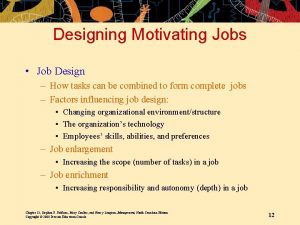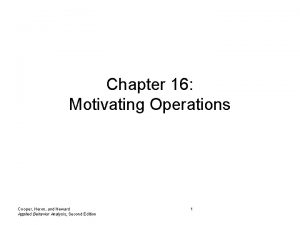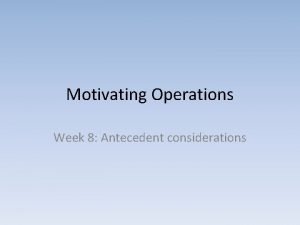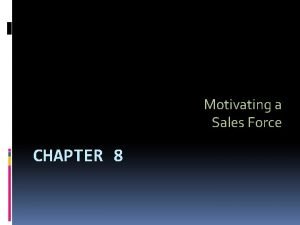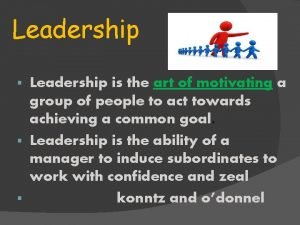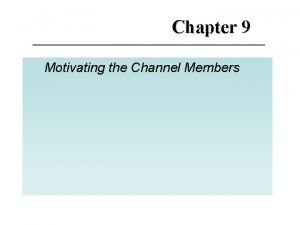GOAL SETTING Motivating people through goal setting Organizational












- Slides: 12

GOAL SETTING Motivating people through goal setting Organizational Psychology Lecture 6

Edwin Locke’s theory of goal setting • 1968 “Toward a Theory of Task Motivation and Incentives” • Employees are motivated by clear goals and appropriate feedback • Working toward a goal is motivating throughout a process and helps to actually reach a goal, which in turn improves performance • Locke’s research: specific and difficult goals lead to better task performance than vague or easy goals • “try hard” vs “try to get more than 80% correct” • Easy goals are not motivating; feeling of accomplishment comes from hard work

Edwin Locke and Garry Latham’s Theory of Goal Setting and Task Performance Five principles of goal setting In order to motivate others, goals must have: 1. Clarity 2. Challenge 3. Commitment 4. Feedback 5. Task complexity

CLARITY goals need to be specific 1. Clear goals can be measured and are distinct and understandable 2. It is clear what behaviors will be rewarded 3. You know what to expect 4. Vague or general instructions like “take initiative” have lesser motivational value 5. “try to correct employees mistakes” – “after each Monday morning meeting speak with employees about their mistakes”

CHALLENGE goals must be difficult but attainable 1. Level of challenge – important characteristic of a goal 2. If a goal has significance, if it’s accomplishment brings achievement – such goal is motivating to be reached 3. Well and adequately rewarded, significant goals boost the enthusiasm and a drive to get them accomplished 4. Easy, viewed as unimportant, goals reduce the effort and commitment of an employee 5. Challenging goals have to be realistic!!! Achievable and attainable

1. COMMITMENT goals must be accepted Goals shall be understood and agreed upon – employees must have an opportunity to be part of creating the goal 2. Participative management: make effort to encourage employees to participate in organizational goal setting as well as own goals 3. Agreed goals lead to commitment 4. Goals shall be consistent with company’s organizational mission, vision and purpose 5. Person assigning the goal should be credible 6. Goal commitment and difficulty of a goal often come hand in hand: the harder the goal the more commitment is needed

FEEDBACK must be provided on goal attainment • Feedback - information of important value to an employee: • provides clarification of expectations, • adjusts goal’s difficulty, • provides recognition – employees basically get to know how they are doing • Feedback can be understood as progress reports; they measure specific success throughout the process of accomplishing a goal • Linking feedback to smaller chunks (intermediate milestones) is an important measure of success • Formal feedback should be provided at the right time

TASK COMPLEXITY • For highly complex tasks it has to be ensured that the work cannot be overwhelming • Sufficient time has to be given for complex tasks • Sufficient time has to be given to learn and improve performance • Sufficient time has to be given for practicing what is important for performance • Goals must be attainable (SMART)

Goal setting follow simple rules • Goal setting means facilitating success • People shall not be frustrated by goals which are too easy or too difficult • Goal setting is necessary for success • Set clear, challenging goals, encourage commitment and provide timely feedback either on milestones (if the goal achieving as a lengthy process) or after the goal is accomplished

Set SMART goals • S – Specific (or Significant) • M – Measurable (or Meaningful) • A – Attainable (or Action-Oriented) • R – Relevant (or Rewarding) • T – Time-bound (Trackable)

Starting to set your personal goals 1. Create big picture: identify large scale goals (in a perspective of 10 years) 2. Break them down to smaller targets to be reached before hitting the large scale goal 3. Once the plan is set start working on it and record your progress 4. Reward yourself for achieving milestones

Glossary • Goal – is the aim of an action or task that a person consciously desires to achieve or obtain • Goal setting – conscious effort to establish such performance as to obtain desirable outcomes • Goal setting theory states that a source of motivation is the desire and intention to reach a goal. So setting goals can be very effective in increasing motivation
 Motivating people for total quality
Motivating people for total quality Motivating parallelism
Motivating parallelism How to motivate esl students
How to motivate esl students Ways of motivating employees
Ways of motivating employees Designing motivating jobs adalah
Designing motivating jobs adalah Transitive motivating operations
Transitive motivating operations Stimulus definition
Stimulus definition Reinforcement theory of motivation
Reinforcement theory of motivation Motivating operations definition
Motivating operations definition Sales force motivation ppt
Sales force motivation ppt Leadership is the art of motivating a group
Leadership is the art of motivating a group Channel motivation meaning
Channel motivation meaning Staffing directing and controlling
Staffing directing and controlling




